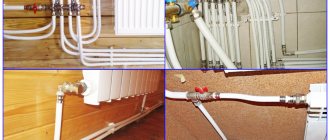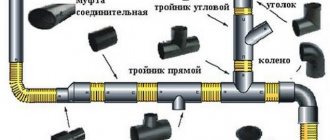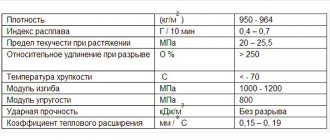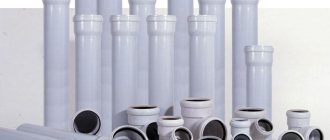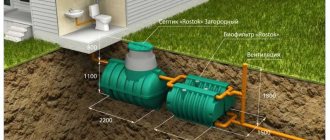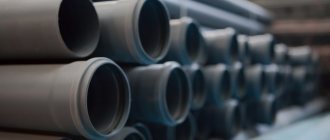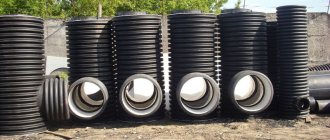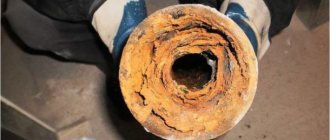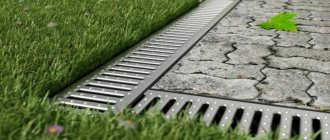Differences from PVC pipes
Many people believe that pipes made of polyvinyl chloride (PVC) and unplasticized polyvinyl chloride are the same thing, but in reality they are not. The presence of one letter in the name, in fact, completely changes the characteristics of the products.
To obtain PVC, plasticizers are added to the polyvinyl chloride composition, which change the properties of the material - making it plastic, soft, viscous, which simplifies processing and, as a result, reduces production costs. PVC is convenient to use, but due to the presence of chlorine in the composition of the substance, it cannot be called completely environmentally friendly: chlorine, albeit in small quantities, begins to be released into the environment during operation.
While uPVC is the safest and most durable plastic, which is also called rigid PVC.
Features of installation and connection of uPVC pipes
Before you begin assembling the pipeline, draw up a diagram of its laying. They select the necessary material (pipes, fittings). To do this, you can use the calculation calculator on the websites of sellers of polymer products.
Laying of sewer channels is carried out with a slope and in the direction towards the drains.
PVC-U materials allow installation to be carried out easily and quickly, without the use of expensive welding equipment or threaded bends, as when installing casing columns.
Connections are made in the following ways:
- Using socket connections through rubber seals.
- By gluing the end and socket of the bends.
- With the use of fittings.
Adhesive connection of uPVC pipes without socket
This joining of the bends is made using a coupling. The parts to be joined are cut at right angles with a fine-toothed hacksaw.
Chamfer at an angle of 15 degrees.
The edges are cleaned of small particles, the depth of the coupling is measured and a mark is placed.
The ends of the pipes and fittings are cleaned with a special solvent and dried.
Glue is applied with a brush to the outer parts of the products and the inner surface of the coupling. To ensure that the glue is evenly distributed over the areas being joined, the parts are turned a quarter turn.
Important! Solvent adhesive is used only that recommended by the manufacturer of pipe products.
Similar connections are used when installing tees, crosses, and various adapters.
Features of uPVC
The raw material for production is unplasticized polyvinyl chloride.
The absence of plasticizers in the chemical formula of the material makes products made from it more rigid and durable. Due to the special structure of the polyvinyl chloride molecule, namely the cross-shaped bonds between the atoms, which give the substance hardness and stability, uPVC can withstand significantly greater mechanical loads than other polymers.
In addition, polyvinyl chloride without plasticizers does not contain chlorine, which means it is safe to use.
The history of the use of uPVC began in the late eighties of the twentieth century. During this time, unplasticized polyvinyl chloride has established itself as one of the most durable and resistant to mechanical deformation types of plastic.
We recommend that you read: Repair of internal and external sewerage systems on your own
Advantages of uPVC pipes
If we talk about the main advantages of uPVC, we cannot fail to note the following:
- the smooth surface of the pipe ensures high throughput and is not subject to overgrowth and does not allow bacteria to multiply on the walls;
- PVC-U pipes are non-flammable and self-extinguishing;
- are not damaged as a result of freezing of the working environment;
- the products are inert to the effects of chemicals, therefore they do not affect the change in taste, smell and color of the working environment;
- do not corrode even after prolonged use;
- easily withstand water hammer and external pressure;
- long service life;
- low specific gravity: the uPVC pipe's mass exceeds the mass of water, so it does not float, which is important, for example, if there is a large accumulation of liquid in wells.
If we talk about the cost of such pipes, they are much cheaper than metal ones, in particular steel ones. Even if you include all the necessary connecting elements in the price, the cost and price of operating a uPVC pipeline will be much cheaper. However, uPVC products are more expensive than HDPE pipes, but the cost is offset by higher performance characteristics, since such pipes are made only from primary raw materials.
Note! UPVC products are difficult to recycle. During processing, those special cross-shaped bonds between atoms that give the material strength are broken, and it becomes brittle. Therefore, recycling not only negatively affects quality, but is also economically unprofitable, since it is more expensive than purchasing and manufacturing a primary product.
The disadvantage of uPVC is its relative fragility as a result of temperature exposure: at temperatures below - 45 ° C, the pipe becomes brittle, and at temperatures above 50 ° C, the material begins to melt and release toxic substances.
Classification, types and range
PVC-U plastic pipes for non-pressure systems are produced in accordance with GOST 32413-2013 (with one wall) and R 54475-2011 (with a structured wall).
In sewer systems, pressure outlets are also used, made of uPVC in accordance with GOST R 51613-2000, designed mainly for water supply and wastewater disposal.
These products have a large number of parameters, so they have many different classifications.
They are usually distinguished by:
- Purpose.
- Strength classes.
- Wall thickness.
- Sizes.
Let's take a closer look at each division.
Standard sizes
For laying street sewerage, uPVC bends with a nominal outer cross-section of 110 mm or more are used.
In this case, its maximum values are for bends:
- Non-pressure single-layer according to GOST 32413-2013 – 1000 mm.
- Multilayer non-pressure according to GOST R 54475-2011 – 1200 mm.
- Pressure according to GOST 51613-2000 – up to 31.5 cm.
For internal wiring, the following sections are used:
- For bends from devices – 25-50mm.
- For a toilet – 110 mm.
- For risers – 110-160 mm.
The length is set by the manufacturer and ranges from one to 6 meters.
Wall thickness
The strength of the product, its ability to withstand soil loads during underground installation, and increased pressure in the channel depend on this parameter. Therefore, in external sewerage, bends with wall thicknesses from 3.2 mm to 24.5 mm are used.
In addition, multilayer pipes of various types are produced:
- Type A - with smooth external and internal walls, between which either a foamed polymer layer or hollow profiles are placed.
- Type B - with a smooth base and an outer profiled layer consisting of annular ribs or profiles of various shapes.
Strength classes
When choosing a product, it is important to know what loads the sewer line can withstand under soil pressure and traffic. Based on this indicator, uPVC pipes are divided into ring stiffness class. It is denoted by the abbreviation SN and powers of 2. It is measured in kilonewtons per m2:
- SN2 – rigidity up to 2 kN/m2 (the main can be laid to a depth not exceeding 1 meter).
- SN4 – up to 4 kN/m2 (placement depth up to 6 m).
- SN8 – up to 8 kN/m2 (canals can be laid under a road section with heavy traffic, maximum depth up to eight meters).
Corrugated bends, for example, belong to class SN8.
PVC-U pressure products are further subdivided according to the amount of internal pressure they can withstand. It is important to keep in mind that PN is not a pressure value, but rather a strength class for this parameter.
| Strength class | Nominal pressure (in MPa) |
| PN6 | 0,6 |
| PN10 | 1,0 |
| PN16 | 1,6 |
| PN20 | 2,0 |
Separation by purpose
According to their purpose, PVC-U pipes are divided into:
- Non-pressure, used in gravity pipelines.
- Pressure, suitable for systems with high operating pressure.
- Corrugated, with increased ring rigidity, used in deep underground areas.
For example, a uPVC pressure pipe with a socket for an adhesive joint is used in laying pressure sewer and water mains. The range includes products with the ability to withstand operating voltages from 0.5 to 16 atmospheres.
Where are uPVC pipes used?
The technical characteristics of unplasticized polyvinyl chloride make it possible to use products made from it for the installation of free-flow and pressure sewer systems, for the supply of drinking water and other liquids: oils, milk and juices in the food industry.
We recommend that you read: How to choose and use a pipe cutter for plastic pipes
Pipes can be used as storm drains and for the construction of drainage systems.
PVC-U products are increasingly gaining popularity as casing pipes for wells due to their ease of installation compared to asbestos-cement and steel casing pipes.
Note! Products are made from unplasticized polyvinyl chloride that must be especially durable against mechanical stress. For example, in the space industry, helmets for astronauts are made from it. PVC-U is also indispensable as a material for the manufacture of skateboards and protective equipment (helmets) for American football players.
Scope of application
PVC-U pipes of 110, 125, 160 and other diameters are widely used both in households and industrial facilities. They can be used in any pipelines designed to transport a working medium with temperatures up to 45 °C. Here are the most common types of these products and their areas of application:
- casing pipe, this PVC-U product is used when drilling wells; it has become an excellent alternative to steel products, since it is absolutely not subject to corrosion. A characteristic feature of these pipes is the presence of a trapezoidal thread (internal on one side, external on the other), which greatly simplifies installation;
Trapezoidal thread casing - domestic and industrial piping systems;
Water supply pressure PVC pipe with O-ring - when installing electrical wiring (corrugated and flat pipes), it is used as a protective sheath for cables;
Corrugated and flat pipe for electric cable - engineering drainage and sewer systems, we will consider this area of application in more detail.
Photo: plastic socket-type free-flow pipe for sewerage systems
Classification according to GOST and marking features
When choosing pipes, it is important to be able to correctly decipher the markings on PVC-U pipe products. The alphanumeric code printed on the walls of the pipe contains all the data about the material, type, size, date of manufacture and technical conditions.
The first letters in the marking indicate the material of manufacture - the letters PVC-U or PVC-U.
Numbers - pipe sizes:
- diameter;
- wall thickness.
The letters TU and numbers are data on the technical operating conditions of the product.
The final numbers are the date of manufacture of the pipe.
| GOST R 51613-2000, TU 22.21.21-034-73011750-2017 | Pressure pipes are used to build water pipelines that can even transport drinking water. Maximum t - up to + 45°C. |
| GOST R 54475-2011 with TU 2248-050-73011750-2016 | Gravity pipes with traditional and reinforced rings are mainly used for the construction of communications - sewerage, sewerage, industrial wastewater. Not suitable for drinking water supplies. The maximum operating temperature is 60°C. It is allowed to transport substances at a temperature of 90°C, but for no more than a minute. |
Use in sewer systems
A sewer pipe made from uPVC can be used both in the reconstruction of sewerage systems and in the installation of new utility systems. This type can be used in technical pipelines used to transport industrial wastewater. Depending on the purpose, PVC sewer pipes come in the following types:
- for internal and storm sewerage, classic gray PVC pipes are installed;
Profile of internal sewerage pipes - for external sewerage (orange). When connecting this type, like the previous type, the socket method is used. That is, the pipe has a special extension (socket), where a rubber gasket is installed, ensuring the tightness of the connection. The diameter of the products varies between 110-630mm; in household systems, as a rule, 110mm pipes are used;
Photo: plastic orange pipe for external sewage systems - Corrugated pipes began to be used relatively recently, so they are rightfully classified as innovative materials. Their scope of application is normal, rainwater (drainage) and sanitary sewerage. In addition, this type of product is in demand in agriculture, in particular, for reclamation systems.
Corrugated products
The main advantages of corrugated pipes are that they retain elasticity, even at subzero temperatures, and are neutral to chemically active substances. Note that when laying pipes in the ground, they can be concreted.
Advantages of PVC pipes
- Pipes come at quite affordable prices, since PVC production is a well-established process.
- PVC is lightweight, so PVC pipes are easy to install, transport, repair and maintain. Most of these operations can be performed alone.
- To install the vast majority of PVC pipes, welding is not required; everything is connected using sockets with rubber seals. To cut a piece of PVC pipe to the required length, you need a simple hacksaw.
- PVC is a non-flammable material, for this reason they can be used in facilities where there is a risk of fire.
- PVC is not a toxic material and does not release any harmful substances into the environment.
- PVC is resistant to corrosion and also does not have chemical reactions with alkali, acids and petroleum products.
Construction and materials of Ostendorf PVC pipes
PVC pipes from Ostendorf are produced using advanced co-extrusion technology. Structurally, the walls of the pipes resemble the structure of bones in animals. This technology makes it possible to significantly improve the functions of polyvinyl chloride and produce pipes and fittings with a smooth inner surface and a core that can withstand pressure from traffic and the severity of soil.
Special elements made of elastomers are installed in the grooves of the sockets for sealing. Even if the pipe bends or becomes deformed, its sealing characteristics will still be maintained. It should also be noted that even pipes up to five meters long have a relatively small weight, so their installation does not require much effort.
